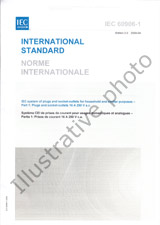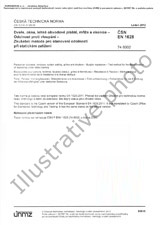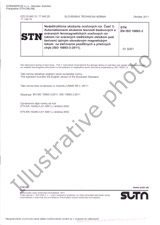We need your consent to use the individual data so that you can see information about your interests, among other things. Click "OK" to give your consent.

IEC 61643-312-ed.1.0
Components for low-voltage surge protective devices - Part 312: Selection and application principles for gas discharge tubes
STANDARD published on 22.4.2013
The information about the standard:
Designation standards: IEC 61643-312-ed.1.0
Publication date standards: 22.4.2013
SKU: NS-413512
The number of pages: 43
Approximate weight : 129 g (0.28 lbs)
Country: International technical standard
Category: Technical standards IEC
The category - similar standards:
Electronic tubesOther equipment for telephone and telegraph communications telecommunication systems
Annotation of standard text IEC 61643-312-ed.1.0 :
IEC 61643-312:2013 is applicable to gas discharge tubes (GDT) used for overvoltage protection in telecommunications, signalling and low-voltage power distribution networks with nominal system voltages up to 1 000 V (r.m.s.) a.c. and 1 500 V d.c. They are defined as a gap, or several gaps with two or three metal electrodes hermetically sealed so that gas mixture and pressure are under control. They are designed to protect apparatus or personnel, or both, from high transient voltages. This standard provides information about the characteristics and circuit applications of GDTs having two or three electrodes. This standard does not specify requirements applicable to complete surge protective devices, nor does it specify total requirements for GDTs employed within electronic devices, where precise coordination between GDT performance and surge protective device withstand capability is highly critical. Keywords: gas discharge tubes (GDT), overvoltage protection in telecommunications, signalling and low-voltage power distribution networks, nominal system voltages up to 1 000 V (r.m.s.) a.c. and 1 500 V d.c. The contents of the corrigendum of July 2013 have been included in this copy. La CEI 61643-312:2013 est applicable aux tubes a decharge de gaz (TDG) utilises pour la protection contre les surtensions des reseaux de telecommunications, de signaux et de distribution basse tension, dont les tensions nominales de reseau sont inferieures ou egales a 1 000 V (valeurs efficaces) c.a. et 1 500 V c.c. Ils sont definis comme un eclateur ou des eclateurs avec deux ou trois electrodes metalliques hermetiquement scellees de sorte que le melange et la pression de gaz soient sous controle. Ils sont concus pour proteger des materiels ou des personnes, ou les deux, contre des surtensions transitoires elevees. La presente norme fournit des informations relatives aux caracteristiques et aux applications des circuits des TDG comportant deux ou trois electrodes. La presente norme ne traite pas des exigences applicables aux parafoudres complets, ni de la totalite des exigences relatives aux TDG utilises dans les dispositifs electroniques, ou une coordination precise entre les performances des TDG et la resistance des parafoudres aux surtensions est primordiale. Mots cles: tubes a decharge de gaz (TDG), protection contre les surtensions des reseaux de telecommunications, de signaux et de distribution basse tension, tensions nominales de reseau sont inferieures ou egales a 1 000 V (valeurs efficaces) c.a. et 1 500 V c.c. Le contenu du corrigendum de juillet 2013 a ete pris en consideration dans cet exemplaire.
These corrections apply to this standard:
Corrigendum 1 - Components for low-voltage surge protective devices - Part 312: Selection and application principles for gas discharge tubes
(Corrigendum 1 - Composants pour parafoudres basse tension - Partie 312: Principes de choix et d´application pour les tubes a decharge de gaz)
Correction published on 16.7.2013
Selected format:Show all technical information.
Similar standards:
1.7.1998
1.1.2014
1.1.2014
1.12.1994
1.12.1995
1.1.1994
We recommend:
Technical standards updating
Do you want to make sure you use only the valid technical standards?
We can offer you a solution which will provide you a monthly overview concerning the updating of standards which you use.
Would you like to know more? Look at this page.


 ČSN ETS 300767-ed.1..
ČSN ETS 300767-ed.1.. STN EN 61643-311..
STN EN 61643-311..
 Cookies
Cookies
